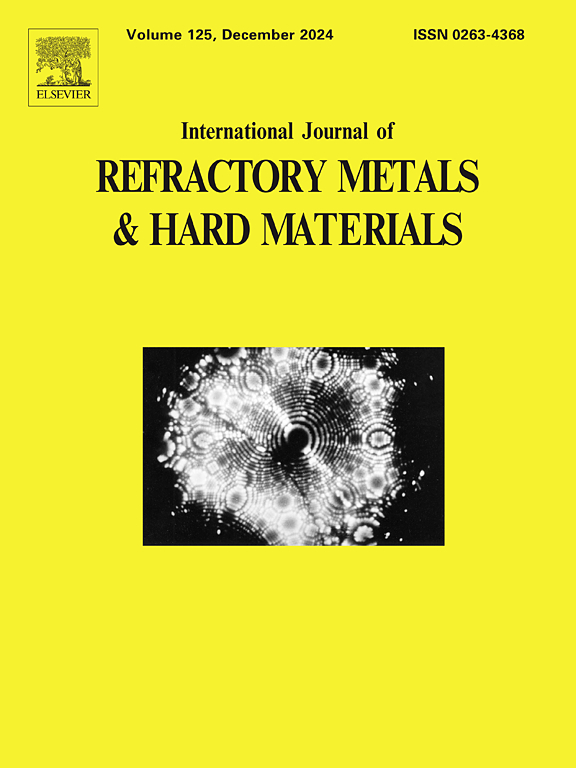W-Ta alloys processed by Laser-Based Powder Bed Fusion: how microstructure and properties change with Ta concentration
IF 4.6
2区 材料科学
Q2 MATERIALS SCIENCE, MULTIDISCIPLINARY
International Journal of Refractory Metals & Hard Materials
Pub Date : 2025-07-10
DOI:10.1016/j.ijrmhm.2025.107324
引用次数: 0
Abstract
In this paper, a study of 4 tungsten‐tantalum binary alloys processed by Laser-Based Powder Bed Fusion (PBF-LB) is presented. The evolution of the microstructure and the properties of the material in dependence on the tenor of tantalum inside the alloy was investigated, selecting 0wt.%, 2.5wt.%, 7.5wt.%, and 15wt.% as the Ta concentrations. The optimal process window for each examined alloy was investigated. The introduction of tantalum in the alloy was effective in mitigating the cracks in the tungsten matrix. However, the energy provided to the material in the additive manufacturing process was also determinant for achieving an almost crack-free and low-porosity material. Moreover, the range of concentrations of Ta considered in this work allowed the authors to see that the properties of the binary alloys examined don't lead to a continuous improvement with the addition of Ta, but start decreasing for Ta contents higher than 7.5wt.%. The minimum porosity volume fraction achieved in this study was 0.7 % for the W-7.5wt.%Ta blend. The same alloy showed the highest hardness among the other materials investigated, reaching hardness values above 480 HV0.5, approximately 30 % higher than what was obtained for pure tungsten, and with a 50 % increase in the ultimate compressive strength compared to the unalloyed material. XRD analyses confirmed that the tantalum particles solubilize completely inside the tungsten matrix, assuring a good homogeneity of the composition and the absence of segregations and secondary phases inside the additively manufactured parts.

激光粉末床熔合加工W-Ta合金:Ta浓度对合金组织和性能的影响
本文研究了激光粉末床熔合法制备4种钨钽二元合金。选择0wt,研究了合金中钽含量随合金组织和性能的变化规律。2.5 wt %。7.5 wt %。%, 15wt。%为Ta浓度。对每种合金的最佳工艺窗口进行了研究。在合金中引入钽可以有效地缓解钨基体的裂纹。然而,在增材制造过程中提供给材料的能量也是实现几乎无裂纹和低孔隙率材料的决定因素。此外,本研究中考虑的Ta浓度范围使作者看到,所检测的二元合金的性能不会随着Ta的加入而持续改善,而是在Ta含量高于7.5wt.%时开始下降。在本研究中,W-7.5wt的最小孔隙体积分数为0.7%。% Ta混合。该合金在其他材料中显示出最高的硬度,达到480 HV0.5以上,比纯钨高约30%,与非合金材料相比,其极限抗压强度提高了50%。XRD分析证实,钽颗粒在钨基体内部完全溶解,保证了成分的良好均匀性,并且增材制造零件内部没有偏析和二次相。
本文章由计算机程序翻译,如有差异,请以英文原文为准。
求助全文
约1分钟内获得全文
求助全文
来源期刊
CiteScore
7.00
自引率
13.90%
发文量
236
审稿时长
35 days
期刊介绍:
The International Journal of Refractory Metals and Hard Materials (IJRMHM) publishes original research articles concerned with all aspects of refractory metals and hard materials. Refractory metals are defined as metals with melting points higher than 1800 °C. These are tungsten, molybdenum, chromium, tantalum, niobium, hafnium, and rhenium, as well as many compounds and alloys based thereupon. Hard materials that are included in the scope of this journal are defined as materials with hardness values higher than 1000 kg/mm2, primarily intended for applications as manufacturing tools or wear resistant components in mechanical systems. Thus they encompass carbides, nitrides and borides of metals, and related compounds. A special focus of this journal is put on the family of hardmetals, which is also known as cemented tungsten carbide, and cermets which are based on titanium carbide and carbonitrides with or without a metal binder. Ceramics and superhard materials including diamond and cubic boron nitride may also be accepted provided the subject material is presented as hard materials as defined above.

 求助内容:
求助内容: 应助结果提醒方式:
应助结果提醒方式:


